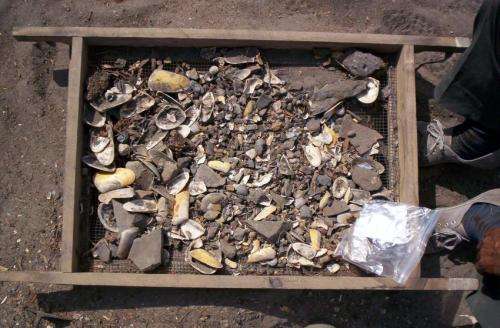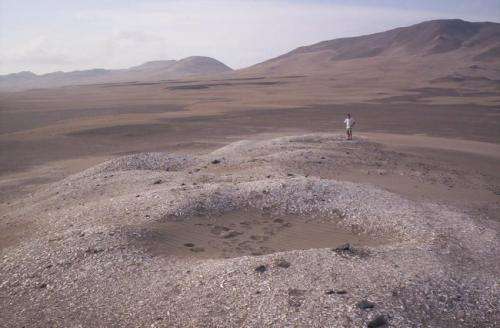August 8, 2014 report
Clam fossils offer 10,000 year history of El Nino Southern Oscillation

(Phys.org) —A research team working in Peru, with members from France, Peru and the U.S. has found a way to track the El Niño Southern Oscillation (ENSO) going back as far as ten thousand years. In their paper published in the journal Science, the team reports that their study of clam fossils has revealed clear patterns of the ENSO and report that it has not been increasing in intensity over the course of the Holocene as some have suggested.
People have been living on the shores of the Pacific Ocean in Peru for a long time, and as they've done so, they've eaten clams, tossing the shells onto waste areas that grew to become huge mounds over thousands of years. In this new effort, the researchers dug down into several such mounds and extracted clam fossils they found, along with dirt and charcoal—remnants of ancient fires used to cook the clam meat. By taking measurements of oxygen isotopes in the clam shells, the researchers were able to calculate ocean surface temperatures at two to four week intervals throughout the lives of the individual clams, while radiocarbon dating of the dirt and charcoal revealed when the clams made their way into the mound. Examining multiple clams at different depths in the mounds allowed for creating a historical record of sea surface temperatures, and that allowed for charting the cycle of the ENSO going back ten thousand years.
The charts created by the research team suggest that the ENSO cycle does not have a predictable cycle and also that it has not been increasing in strength over the course of the Holocene as others have suggested. They did find some patterns, however. During a period approximately 4,000 to 5,000 years ago, for example, the ENSO was relatively weak, and during another period, from 6,700 to 7,500 years ago, ocean temperatures along the coast of Peru appeared to have been skewed by the location of warm water from an El Niño (when trade winds push warm water into the Eastern Pacific.)

The findings by the team also cast doubt on some theories that have been developed to explain why the ENSO occurs at all—primary among them are those that suggest they are due to a slight wobble in the Earth's orbit. If that were the case, it would seem logical to conclude that an identifiable periodicity would emerge over the course of ten thousand years, but now, that doesn't appear to be the case.

More information: Holocene history of ENSO variance and asymmetry in the eastern tropical Pacific, Science DOI: 10.1126/science.1252220
ABSTRACT
Understanding the response of the El Niño-Southern Oscillation (ENSO) to global warming requires quantitative data on ENSO under different climate regimes. Here, we present a reconstruction of ENSO in the eastern tropical Pacific spanning the last 10 thousand years (ka) derived from oxygen isotopes in fossil mollusk shells from Peru. We find that ENSO variance was close to the modern level in the early Holocene and severely damped ~4-5 ka. In addition, ENSO variability was skewed toward cold events along coastal Peru 6.7-7.5 ka owing to a shift of warm anomalies toward the Central Pacific. The modern ENSO regime was established ~3-4.5 ka. We conclude that ENSO was sensitive to changes in climate boundary conditions during the Holocene, including, but not limited to insolation.
Journal information: Science
© 2014 Phys.org

















